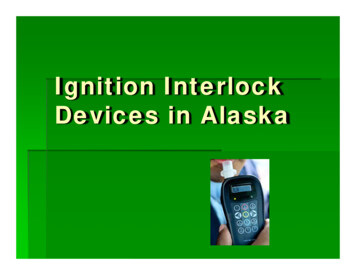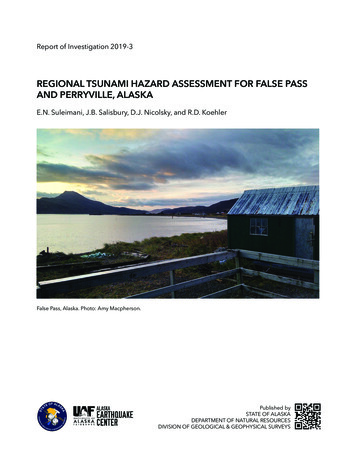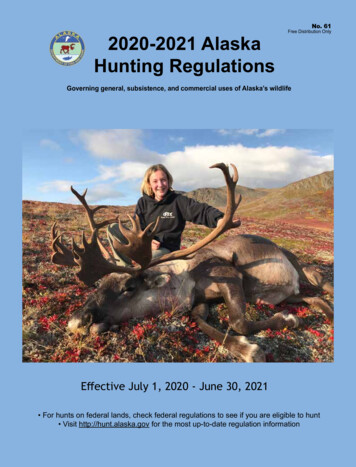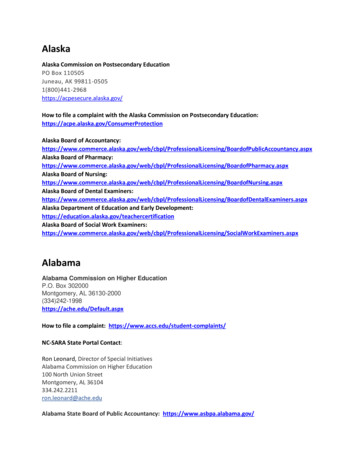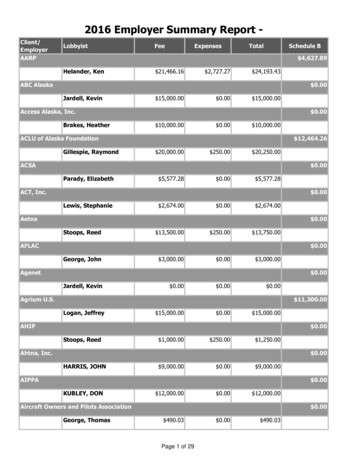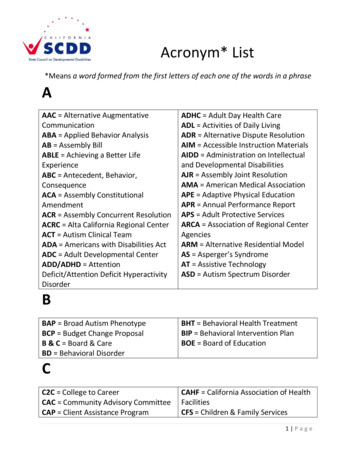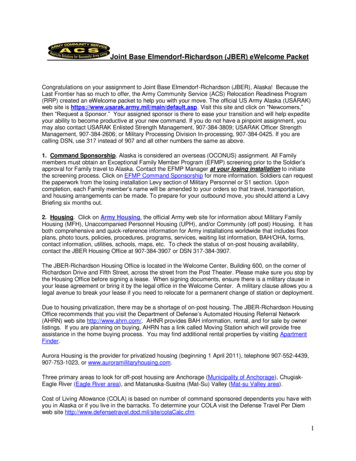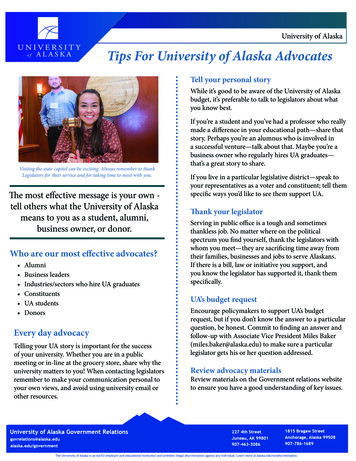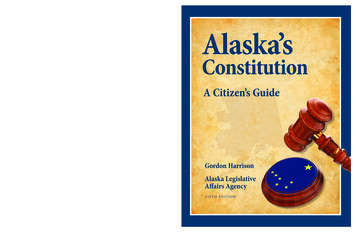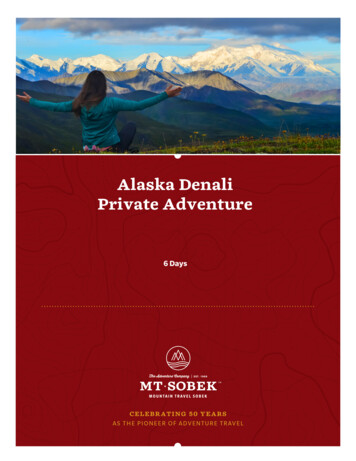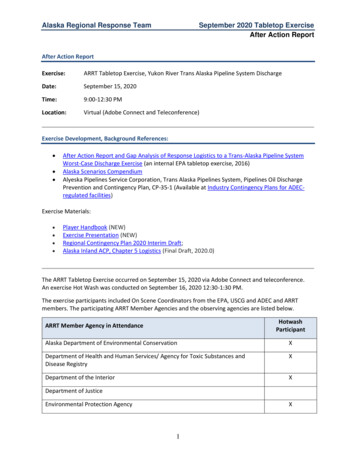
Transcription
Alaska Regional Response TeamSeptember 2020 Tabletop ExerciseAfter Action ReportAfter Action ReportExercise:ARRT Tabletop Exercise, Yukon River Trans Alaska Pipeline System DischargeDate:September 15, 2020Time:9:00-12:30 PMLocation:Virtual (Adobe Connect and Teleconference)Exercise Development, Background References: After Action Report and Gap Analysis of Response Logistics to a Trans-Alaska Pipeline SystemWorst-Case Discharge Exercise (an internal EPA tabletop exercise, 2016)Alaska Scenarios CompendiumAlyeska Pipelines Service Corporation, Trans Alaska Pipelines System, Pipelines Oil DischargePrevention and Contingency Plan, CP-35-1 (Available at Industry Contingency Plans for ADECregulated facilities)Exercise Materials: Player Handbook (NEW)Exercise Presentation (NEW)Regional Contingency Plan 2020 Interim Draft;Alaska Inland ACP, Chapter 5 Logistics (Final Draft, 2020.0)The ARRT Tabletop Exercise occurred on September 15, 2020 via Adobe Connect and teleconference.An exercise Hot Wash was conducted on September 16, 2020 12:30-1:30 PM.The exercise participants included On Scene Coordinators from the EPA, USCG and ADEC and ARRTmembers. The participating ARRT Member Agencies and the observing agencies are listed below.HotwashParticipantARRT Member Agency in AttendanceAlaska Department of Environmental ConservationXDepartment of Health and Human Services/ Agency for Toxic Substances andDisease RegistryXDepartment of the InteriorXDepartment of JusticeEnvironmental Protection AgencyX1
Alaska Regional Response TeamSeptember 2020 Tabletop ExerciseAfter Action ReportFederal Emergency Management AdministrationU.S. Coast GuardXDepartment of Commerce, National Oceanic and Atmospheric AdministrationXDepartment of EnergyExercise Observer AgenciesAlaska Department of Fish and GameAlaska Department of Natural Resources, State Pipeline Coordinators SectionXDepartment of the Interior, Bureau of Indian AffairsXDepartment of the Interior, Bureau of Land ManagementDepartment of the Interior, U.S. Fish and Wildlife ServiceXHilcorp Alaska LLCUSCG, National Pollution Fund CenterThis exercise did include one functional aspect: a testing of the USCG’s Alert Warning System. ARRTMembers and Agency Representatives were sent a voice, text and email message notifying them of theexercise. This system allows for recipients to respond to the message indicating their if they would beparticipating in the exercise. This test of the Alert Warning System had the following results: 45 notifications sent34 responses received11 non-responsesNo members/representatives reported a failure to receive the message, although some members didnot get the message in all three formats. Corrections and additions to the contact list will be made perfeedback received.All participants providing feedback regarded the exercise as a valuable experience. Participants lookedfavorably upon: The organization and presentation of the exercise;Use the Adobe Connect to facilitate involvement of ARRT members, especially those fromagencies that are not ‘key players’ in an incident response;The scenario’s ability to depict the challenges and scope of responding to a significant dischargeto the Yukon River, with thousands of miles of potentially oiled shoreline; dozens of potentiallyimpacted communities in remote Alaska.2
Alaska Regional Response TeamSeptember 2020 Tabletop ExerciseAfter Action ReportThe input from participants regarding areas for improvement was generally focused on the need tofurther identify options and resources for resource gaps, these are described in “Key Exercise Areas forImprovement.”Key Exercise Strengths: Excellent scenario to highlight the substantial challenges of a response to significant discharge inremote Alaska, particularly with an immense impact area (2500 miles of shoreline)Scenario and resources requests focused on identification of gaps in staffing andequipment/supplies and challenges in deploying these resources and supporting fieldoperations.o Key challenges to Filling Gaps: Mid-summer response is during peak field season. Agency assents (personneland equipment) are deployed for field assignments. DOD and USCG personnel and equipment, if available, are not available for longterm re-assignment to a spill response.Resources requests sought input from agencies not typically providing assets to a response;o Good use of Adobe Connect to allow for input via chat and “raise hand” function tofacilitate discussionsResource Gaps Identified in Exercise Transportation logistics for responders – deploying to field base camps and for daily responsework: fixed wing, helicopter, and boats.o Local Transportation was out of scope of the scenario. Availability of ATVs and otherground transportation should be explored in a future exercise.o Fixed wing aircraft are more common than helicopters.o Fire Service Aircraft is generally committed to Alaska Fire Service missions or re-assignedto Lower 48 in the event of a low-risk/low-incident year.o Boats are likely deployed for regular summer field work.o USCG does not have any vessels suitable for the Yukon River.o DOD and USCG aircraft are assigned to primary agency missions and are unlikely bereassigned to response for long-term use. Need to explore options and availability of Alaska-based aircraft.Training/ Just-in-Time Training. Many responders will require mission-specific and safety trainingprior to assignment. This may include SCAT training, HAZWOPER, and wilderness safety.o Potential Solution/ HAZWOPER: USCG can provide HAZWOPER training. OSHA may alsobe able to assist (8-hour refresher and 24- or 40-hour course)o Potential Solution/ SCAT Training: NOAA can provide SCAT training in a half-day course.Key Exercise Areas for Improvement: Include cost for resources in the agency reply to Resource Requests.o Examine options for costing for non-traditional assets, or from agencies not typicallyproviding resources to an NCP incident (FEMA, GSA, FAA)Include assets of additional bureaus/agencies within the ARRT Member Department. (ExampleDOD member from Navy was unable to speak to assets of Air Force or Army located in Alaska.)3
Alaska Regional Response TeamSeptember 2020 Tabletop ExerciseAfter Action ReportIssues Raised without Resolution During Exercise: Mapping & Situational Awareness.o Can NOAA’s ERMA mapping application be used to maintain situational awareness, orwould industry provide a mapping application for this purpose?o What limitations are there regarding sharing of proprietary or sensitive data?Finance & Cost Issues:o Agencies need to assess which of their resources have pre-assigned costs associatedwith their use during a response;o ARRT should assist member agencies to determine how cost reimbursement to nontraditional response agencies can be accomplished, especially those not identified inNCP (FEMA, GSA, FAA)Future Exercise Planning/ Exercise Recommendations: Provide resource requests in advance to allow ARRT members to query/involve additionalDepartment bureaus/agenciesRefine the scope furtherInclude in scenario narrative the member agency’s roles in Incident Management and response(their non-ARRT, response duties)Ensure, to extent practical participation of members not able to attend this tabletop – inparticular those that have equipment that could support response: DOD Alaska Command, GSA,and U.S. Forest Service.Include Spill of National Significance and/or State and Presidential Disaster Declarationin scenario. This would make additional resources available that should be examined.Explore transfer of command from EPA to USCG FOSC; See Refugio Beach Spill AfterAction Report/Lessons Learned.Explore response beyond Day 4 of months-long response.4
Alaska Regional Response TeamSeptember 2020 Tabletop ExerciseAfter Action ReportCorrective Action Plan:The following recommendations should be distributed to the ARRT Statewide Planning Committee Improve understanding of ARRT Members that they represent their entire departmentand not just their agency. Consider appropriate ARRT Members and if the assignedindividually can really represent the full department especially if they are locatedoutside of Alaska.Review changes in content for Alaska Inland ACPo Planning Chapter: Review plan content on Situation Unit and Mapping for thefollowing: Use of industry (RP/RRP) mapping platforms vs. government platforms (i.e.Arctic ERMA)What limitations are there regarding sharing of proprietary or sensitive data,sensitive infrastructure (i.e. ports), investigative, or other legally discoverableinformation subject to due process?o Finance Chapter: Review plan guidance regarding cost tracking of federal andstate department resources. Including the following subjects: Cost tracking and reimbursement of resources without pre-assigned costsassociated with their use during a response;Cost tracking and reimbursement of resources from agencies not described inthe NCP (i.e. FEMA, GSA, FAA)5
Alaska Regional Response TeamSeptember 2020 Tabletop ExerciseAfter Action ReportDepartment of the Interior Comments and Inject ResponsesFor context regarding DOI’s role(s) - Resources at Risk managed by our agency include:Anadromous salmon. The USFWS has international treaty obligations with Canada for salmonescapement in the Yukon River and their Fairbanks Field Office would immediately be notified aboutspills in the Yukon. The FWS and Alaska Department of Fish and Game coordinate constantly regardingin-season management of the Yukon River fishery.Other fisheries resources used for subsistence include whitefish, Burbot, pike, and anadromousSheefish, and their habitats. Rampart Rapids, downstream from the bridge, is a significant fish camplocation for people from Tanana, with at least two or three fish wheels running every summer. Fishcamps exist along the river.Many migratory bird species managed by USFW utilize the Yukon River and associated riparian habitatsfor nesting, rearing of young, and/or migration during the spring and fall. Of particular concern duringan oil spill, due to their life history characteristics, are raptors including peregrine, bald eagle, andosprey nest along the Yukon River corridor.As noted later within the presentation, the FWS would not have any Threatened and Endangeredspecies concerns.FWS, BLM and BIA would have concerns regarding impacts to subsistence resources. Most conservationunits in Alaska (e.g., refuges, national parks, and public lands) were established, in part, to provideaccess to subsistence resources.BIA also has concerns regarding restricted lands (discussed later), cultural resources, biologicalresources, and forest resources.Land management responsibilities of the USFWS, BLM and BIA will be discussed in more detail later,when considering sensitive areas.Unified Command:DOI anticipates that multiple trained specialists would be available to work within the Unified Commandto support EPA’s efforts. These would include wildlife agency staff, a NRDAR liaison (essential given themagnitude of this spill), and other technical specialists. This support would include staff operatingwithin the Incident Command Post and those providing support from other locations.The BLM’s Pipeline Monitoring and Environmental Compliance Section plays an oversight role regardingTAPS operations. Their staff would be actively be involved within the Unified Command. One BLM Environmental Protection Specialist would report (fly) to Fairbanks EOC to oversee Alyeska’s response actions/coordinate with PMECS field personnelOne Realty Specialist can work remotely to provide any land use permit issues One Geologist can work remotely to provide assistance in coordinating any material use issuesfrom mineral material sites in the area6
Alaska Regional Response Team September 2020 Tabletop ExerciseAfter Action ReportTheir section has a PIO available and BLM staff have brought them in on exercises to work in theJIC in the past (new information provided after the exercise)BLM also plays a significant land management role within the Yukon River corridor.The BIA would also play a key role in supporting the response, within the Unified Command and/or fromother office locations. Alaska Native allotments, discussed later, would be a significant concern.Additionally, DOI would check with other DOI bureaus (e.g., NPS and USGS) to see what incident-specificexpertise they could offer.The need for historic property specialist support for field operations (SCAT) is discussed later. HPS andcultural resource manager involvement in the spill response within the Unified Command is alsoessential. DOI recommends that identification of an HPS to advise the FOSC be a high priority as soon aspossible during the spill. This urgency reflects the great abundance of historic properties and culturalresources we anticipate may be impacted, given the number of communities, fish camps, historic, andarchaeological sites located throughout the Yukon River corridor downstream of the spill. The FOSC’sHPS would coordinate with the State Historic Preservation Officer (SHPO) and subject matter expertsrepresenting the responsible party regarding historic properties issues. DOI, in coordination with theSHPO, could help the FOSC identify potential HPS candidates.Field assets:From BLMs Pipeline Monitoring and Environmental Compliance Section: Three field personnel assigned in Fairbanks able to respond upon notification – Two Maintenance and Operations Specialists to oversee Alyeska’s field operations depart Fairbanks for Pump Station 6/Yukon Response Base in their assigned truckOne Environmental Engineer to Alyeska’s Fairbanks EOC to observe Alyeska’s Engineeringsection’s repair actions to return pipeline to serviceThe USFWS manages several very large National Wildlife Refuges throughout the Yukon Riverwatershed. Their potential response assets are discussed below.The Nowitna National Wildlife Refuge is located 100 miles downriver from the TAPS Yukon Rivercrossing. The western boundary of the Yukon Flats NWR is upriver about 10 miles. During type ofincident FWS spill response staff would ask the Refuges for assistance, if needed (personnel for wildlifeobservations, boats, and such).FWS HAZWOPER-certified employees7
Alaska Regional Response Team Fairbanks: 16 Anchorage: 30Tok: 2 Other areas in AK: 21September 2020 Tabletop ExerciseAfter Action ReportPrimarily biologists, refuge maintenance staff, and FWS law enforcement officers. Time to arrive onscene varies depending on location, but could start arriving within 48 hours, particularly from Fairbanks.Helicopter travel for FWS staff on non DOI certified aircraft may be possible, however this wouldnecessitate development and signing of a cooperative agreement. Agreements can be obtained withinone working day (meaning there may be a delay over the weekend). Additionally, FWS employees mustwear OAS-approved helmets during flight. Availability of approved flight helmets may limit number ofFWS employees able to fly.2. If you cannot answer the question –Respond with how much time you need to determine capability.FWS would be able to provide a better estimate within 8 hours and more specifics within 24.NPS would need at least 24 hours (more if over the weekend) to determine NPS cultural resourcespecialist capacity.Slides 32-33:Tribal notificationsThe slide says tribes have been notified. If additional assistance is needed, NPS has SOI-qualified culturalanthropologists that could help with tribal notifications. To my knowledge none have the 24-hourHAZWOPER but they could help with notifications from an office setting. Estimate of 2 anthropologistsavailable. Time to mobilize to FAI would be 2 days or less.Slide 34: Sensitive/protected areas – shows Innoko and Yukon Delta NWRs,The spill would almost immediately impact BLM managed public lands along the Yukon River directlybelow the spill origin and in many sections of the river downstream. DOI would work with BLM togenerate land status maps/data layers which would be provided to the Unified Command. As notedabove, BLM would also be represented in the Unified Command.Alaska Native allotments would also be impacted almost immediately following the discharge of oil. TheBIA has trust responsibility for restricted lands (including allotments and townsites). More than 50 suchallotments could be impacted between the spill origin and Tanana. This number is based on my quickreview of a generalized land status map and it is almost certainly too low. Allotments are also foundthroughout the Yukon River corridor downstream of Tanana. BIA would work to identify impactedallottees as the spill progresses downstream, and to facilitate communications with them.8
Alaska Regional Response TeamSeptember 2020 Tabletop ExerciseAfter Action ReportBased on the map on page 18, discharged oil would enter the western boundary of the Nowitna NWR byhour 35 / Day 2. As discussed on this slide, the Innoko and Yukon Delta NWRs would be impacted later.FWS spill response staff would coordinate with their refuge counterparts regarding resources at risk andother issues.Slides 40-42: SCAT teams, including HPS supportFWS could supply 1-2 field personnel for this within 24-48 hours, although they would overlap withpersonnel requested on slide 43, at least initially (with helicopter caveats from above).NPS had a good number of CR staff at the 2019 HPS workshops and all are SOI qualified, but few to nonehave the 24-hour HAZWOPER training. Would “just in time” HAZWOPER training be available?NPS cultural resource staff in Alaska would contact their counterparts in the lower 48 and they expectthat they could find 1-3 people available with HAZWOPER certification. Mobilization would likely take 23 days to FAI.FWS may be able to provide cultural resource support. They would know within 2-3 days whether aCultural Resource Specialist/ Secretary of Interior Qualified Archaeologist would be available. Thisperson’s role might be within the Unified Command or field (TBD)? Addition – after the exercise Ilearned this responder lacks HAZWOPER certification, so their role would either be limited to providingsupport to the UC, or that person would need “just in time” training.Other DOI staff might be available for SCAT team support (TBD), depending on their training andavailability.Wildlife Observers:In addition to SCAT, FWS may also be able to provide other field staff, particularly deployment of wildlifeobservers. DOI recommends inclusion of trained wildlife observers in the response, as outlined in theWildlife Protection Guidelines.Slide 43: Request for support for water and sediment sampling, biological (food safety) sampling,etc. USGS, FWS and others might have staff but are they HAZWOPER trained?FWS could supply 3-5 HAZWOPER certified personnel for this within 24-48 hours, although they wouldoverlap with personnel requested on slides 40-42 (with aviation support caveats from above).Slide 50: Would your agencies be able to supply your own staff with camping essentials and would youhave spare tents, etc.9
Alaska Regional Response TeamSeptember 2020 Tabletop ExerciseAfter Action ReportFWS would be able to outfit their own staff with camping equipment from Field Offices and NationalWildlife Refuges. They would require 4-5 days to determine if extra gear were available. That may beunlikely during the summer field season.HPS or other cultural resource staff from NPS and FWS would have field gear.DOI would also coordinate with other bureaus to assess resource availability.Slide 51: Availability of helicopters to help support spill response efforts?Our office would work with the DOI Office of Aviation Services (OAS) to assess this request. They in turnwould coordinate with Regional Aviation Managers in the FWS, BLM and NPS to determine aviationresource availability. I believe DOI may have some helicopters, however fixed wing aircraft are muchmore common.This spill would occur at the height of the field season for DOI biologists, cultural resource specialists,physical scientists and others. Also, a number of the aircraft in the DOI fleet are dedicated to wildfireresponse (e.g., BLM Alaska Fire Service). It is unlikely these wildfire-related assets could be freed up,given this mission critical need. If there is a less active fire season in Alaska, these AFS aircraft would berepositioned to the Lower 48, as occurred this year.Each DOI bureau would need to evaluate field crew support and safety issues and mission critical workprior to committing aircraft.Helicopter travel for USFWS staff on non-DOI certified aircraft may be possible, but requires acooperative agreement and USFWS employees must wear OAS-approved helmets during flight.Agreements can be obtained within one working day (meaning there may be a delay over the weekend),Availability of approved flight helmets may limit number of FWS employees able to fly.Additionally, as a preliminary response, the FWS noted that they would not be able to support thehelicopter request, but 1-2 fixed-wing aircraft might be available. These aircraft would be outfitted withfloats or tundra tires and have experienced pilots. These types of aircraft can operate along the YukonRiver with its numerous gravel bars, wide expanses of water, and small gravel strips. Would need atleast 24 hours to determine availability. I believe that FWS is not alone in having more fixed wingaircraft vs. helicopters.Another capability DOI has had in the past was the ability to support various missions (wildfires, volcanicevents, science missions) through use of Unmanned Aviation System (UAS) aircraft and trained pilots. Iunderstand that DOI has the largest civilian government fleet. I previously heard that our fleet wasgrounded due to cybersecurity concerns. I just checked and the fleet is still grounded.Slide 52: Similar question re: river boats10
Alaska Regional Response TeamSeptember 2020 Tabletop ExerciseAfter Action ReportThe USFWS Fairbanks Field Office Fisheries programs, Fairbanks-based National Wildlife Refuges (YukonFlats and Arctic), and downriver National Wildlife Refuges (Nowitna, Innoko, Yukon Delta) have multipleriver boats. The FWS expects 1-2 boats with operators could be available within 48 hours and more maybe requested if needed. They would need 2-3 days to query all sources.DOI would also reach out to other bureaus to determine if other boats and/or trained boat operatorswithin Alaska could be made available to support this spill response. As mentioned above, this would beat the height of field season, and field crew safety and support issues would take precedence.11
Alaska Regional Response TeamSeptember 2020 Tabletop ExerciseAfter Action ReportNational Pollution Fund Center CommentsFrom: Buie, Gregory W CIV Gregory.W.Buie@uscg.mil Sent: Wednesday, September 16, 2020 8:37 AMTo: Goolie, Mary Goolie.Mary@epa.gov ; Sheldrake, Beth sheldrake.beth@epa.gov ; Everett, MarkCIV Mark.Everett@uscg.mil ; Randolph, Marc A CIV Marc.A.Randolph2@uscg.mil ; Fisher, Samantha sfisher@ene.com Cc: Eastman, Timothy G CIV Timothy.G.Eastman@uscg.mil ; HQS-SG-NPFC CMTEAM3 HQS-SG-NPFCCMTEAM3@uscg.mil Subject: Alaska Regional Response Team Table Top Exercise - thoughts for hotwashI thought the exercise was very well planned and well run and it certainly raised a lot interestingquestions and spotlighted the challenges for the AK response community and the AKRRT.Integrating RRT agency support into the UC's resource ordering process is always challenging, andprobably even more so in Alaska. The resource requests of yesterday's exercise were very thoughtprovoking; I was often asking myself "how would we do that in the real world?"At the end of the day I think it comes down to effectively and rigorously using the standard ICS 213RRresource request and ordering process. From NPFC's perspective; we prefer the RP provide as muchtactical and logistical support as possible, with government resources backstopping the RP as necessary e.g. the Army Chinook helicopters that were used during the MODU KULLUK response.( https://www.army.mil/article/94329/army helicopters aid stranded oil rig )NPFC recognizes that the NCP and Area Plans often lay out inherently governmental Federal, State,Tribal, and Local government roles in response that need funding and that RPs may not be able to easilyreach funding or "vendor" agreements with government agencies in the heat of a response . That iswhere the NPFC and the OSLTF can help with the PRFA and MIPR process.Nationally, NOAA, DOI, SUPSALV, and the bigger coastal states are pretty familiar with these processes,but many Federal, State, Local, and Tribal agencies and DOD elements are not because of the relativeinfrequency of large spills.If the AKRRT desires, I could provide a presentation or participate in a future workshop to explain howthese processes work and provide some real world examples of how the OSLTF was used to fund agencyefforts alongside RP efforts on major oil spills.GregPs. I have attached an excellent DOI guidance document on how DOI Bureaus and Offices can use PRFAsto fund activities that support FOSCs. It can be found ds/ecm 164 department procedures related to pollution removal funding authorizations issued by federal.pdf12
Include in scenario narrative the member agency's roles in Incident Management and response (their non-ARRT, response duties) Ensure, to extent practical participation of members not able to attend this tabletop - in particular those that have equipment that could support response: DOD Alaska Command, GSA, and U.S. Forest Service.
